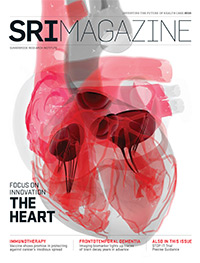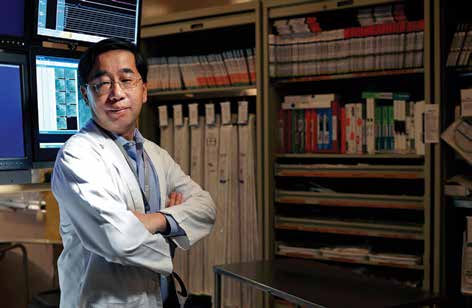HOT: The Heart Outcomes Team Is Steering Prevention, Practice and Policy
New studies show Canadians have a long way to go toward achieving ideal cardiovascular health; chest pain patients do best when seen after leaving emergency room; and better criteria might be needed for selecting who should have coronary angiography
June 15, 2015

The research of Dr. Dennis Ko (centre) has highlighted the importance of physician follow-up in lowering the risk of death or heart attack among patients discharged from the ER after chest pain.
At Sunnybrook Research Institute (SRI), a tightly knit team of about 30 people is working to advance cardiovascular outcomes research with the goal of improving the lives of those with heart disease and other cardiac conditions. The team includes scientists Dr. Jack Tu, Dr. Dennis Ko and Dr. Harindra Wijeysundera of SRI’s Schulich Heart Research Program, along with research coordinators, epidemiologists, statisticians and data-management experts.
While more Canadians are surviving a heart attack or stroke than ever before, some aren’t able to make and maintain potentially life-saving behaviour changes, according to the Heart and Stroke Foundation’s 2014 Report on the Health of Canadians. Over the last 60 years, the death rate from these conditions has declined more than 75%, which means that now more than 90% of Canadians who have a heart attack and more than 80% who have a stroke who make it to the hospital will survive. While this is encouraging news, more work needs to be done so that even more lives can be saved, and the quality of those lives improved.
Ko, Tu and Wijeysundera are doing some of that work as clinician-scientists, guided in their research by the patients they see. Their studies influence how cardiologists and other doctors practise, and have an impact on the creation of policies. One such study was the CANHEART health index, a tool for monitoring the cardiovascular health of Canadians, on which Tu was the principal investigator.
Tu and his team developed the Cardiovascular Health in Ambulatory Care Research Team (CANHEART) health index, analyzing trends in health behaviours and factors, to monitor the heart health of Canadians. “We had done a lot of previous research work in hospital settings treating cardiac patients, but we also wanted to work on prevention,” says Tu, who is also a cardiologist at Sunnybrook. “We felt that this would lead to a greater contribution to population health outcomes.”
The CANHEART health index, which was published in the Canadian Medical Association Journal, was produced in partnership with the Heart and Stroke Foundation, which has set these mission impact goals by 2020: to improve the health of Canadians significantly by reducing their risk factors for heart disease and stroke by 10%; and to reduce Canadians’ rate of death from heart disease and stroke by 25%. “These are ambitious goals, and [the timeline] is only five years away,” says Tu. “There was a sense of immediacy in setting this challenge for Canadians.”
Prior to developing the CANHEART health index, there were no commonly accepted measures of how healthy or unhealthy Canadians were in terms of their cardiac health. Adapting the concept of “ideal cardiovascular health” first promoted by the American Heart Association and using data from Statistics Canada’s Canadian Community Health Survey, the research team examined trends in the prevalence of the following six cardiovascular health factors and behaviours: smoking; physical activity; fruit and vegetable consumption; overweight/obesity; diabetes; and hypertension.
The number of ideal metrics was summed to create the CANHEART health index; the values range from 0 (worst) to 6 (best or ideal). “We found that three of the behaviours are getting worse and three are getting better,” says Tu, pointing to an improvement in rates of smoking cessation, leisure-time physical activity, and fruit and vegetable consumption but worsening levels of obesity, hypertension and diabetes.
In spite of the improvements, however, the findings revealed that fewer than one in 10 Canadian adults and one in five youth were in ideal cardiovascular health from 2003 to 2011. Based on those statistics, intensive health promotion activities are needed to meet the Heart and Stroke Foundation’s mission impact goals for 2020.
“While we did see some improvements in certain health behaviours, the findings suggest that other factors are driving the obesity increase,” says Tu. “Overall, diet is likely a contributing factor. For example, while we did find that Canadians are eating slightly more fruits and vegetables, they may also be may be consuming more of other foods that aren’t as good for the heart. And total physical activity and sedentary sitting time is important, not just the leisure-time physical activity for which we had data.”
These findings should help patients be more aware of their habits and show them where there is room for improvement—and there’s a lot of it, considering that only 10% of the participants were in ideal health. “Some family doctors are using the findings to counsel cardiac patients,” says Tu. “Often what happens is that people don’t do anything to change their unhealthy behaviours until something bad happens, when what they should be doing is trying to prevent their first heart attack or stroke from happening.”
Discharged From the ER After Chest Pain? See Your Family Doctor
In developed countries, chest pain is among the most common reasons for emergency department (ED) assessment. Although more than 80% of patients with chest pain are discharged from the ED after evaluation, the optimal physician follow-up for these patients remains unclear.

Dr. Jack Tu led the development of the Cardiovascular Health in Ambulatory Care Research Team (CANHEART) health index to evaluate the heart health of Canadians.
Ko is an interventional cardiologist at Sunnybrook, in addition to his SRI appointment. He and his team had conducted three studies on the importance of physician and cardiologist follow-up for high-risk patients with chest pain after ED assessment when they decided that a similar study for low-risk patients was warranted. Low risk was defined as age 50 years or older with no diabetes or pre-existing heart disease; high-risk patients in that same demographic had those conditions. “We aren’t sure what’s the best thing to do for the low-risk patients,” he says. “We’re interested in understanding what the best care is for these patients after they’ve been discharged from the emergency room.”
Ko, along with Tu and Wijeysundera, performed a retrospective observational study of low-risk chest-pain patients who were assessed and then sent home from an Ontario ED. The findings revealed that following discharge, of 216,527 patients, 29% had no physician follow-up, 60% had primary care physician alone, 8% had primary care physician with cardiologist and 4% had cardiologist alone. The mean age of the patients was 64 years, and 42% of them were men.
The conclusion was that in these low-risk patients, follow-up with a primary care physician and a cardiologist in the first 30 days after being discharged was associated with a significantly lower risk of death or heart attack after one year. Specifically, follow-up with a primary care doctor and cardiologist was associated with a 19% reduced risk of death or heart attack, and a 27% lower risk of death compared with no follow-up. Patients who saw only a cardiologist also had a significant 20% reduction in the risk of death compared with no physician follow-up. “It showed that if you follow up with a physician, the outcomes are much better,” says Ko. “And if you see a cardiologist, the outcomes are the best.”
Snapshot: How Research Changed Cardiac Care
Before the EFFECT study was released in 2009, despite much debate, few data existed to determine whether publicly released report cards on hospital performance improved quality of care.
The Enhanced Feedback for Effective Cardiac Treatment (EFFECT) study was a population-based cluster randomized trial of 86 Ontario hospitals of patients admitted for acute myocardial infarction (heart attack) or congestive heart failure. The decade-long trial was groundbreaking.
“This was the first time anywhere in the world that a large randomized trial had been done to rigorously evaluate cardiac report cards across hospitals to determine how cardiac patients were being managed,” says Dr. Jack Tu, the SRI senior scientist who was the study’s principal investigator. (Dr. Dennis Ko was a co-author.)
The scientists released two report cards, one deemed “early” in 2004 that reported on one-half of the hospitals and another deemed “late” 18 months later. “We found that the early report-card information was used by many of the early- and even some of the late-feedback hospitals,” says Tu. “It was helpful in that they could see how they were doing compared to other hospitals.”
The study found that, overall, there was room for improvement. A follow-up survey showed that many hospitals had changed their cardiac care practices after participating.
“Some of the hospitals introduced standardized critical care admission orders and protocols for how they managed heart attack patients,” says Tu. “They gave their patients quicker ECGs, and the emergency room doctors were permitted to give clot-busting drugs rather than wait for a cardiac specialist to arrive.” Certain hospitals opened heart failure clinics to ensure that patients got put on the right medication and stayed on it, to prevent readmission.
“The EFFECT study was a big wake-up call for the Ontario health care system,” says Tu. “We know that heart attack and heart failure mortality in Ontario has improved since then, and we believe this study was an important contributing factor. We estimated at the time of the first early feedback report that we could save 400 more lives each year in Ontario if all hospitals were providing optimal cardiac care.”
The EFFECT study was funded by the Canadian Institutes of Health Research and the Heart and Stroke Foundation of Canada.
Part of this, the authors noted, is that seeing a cardiologist, with or without a primary care physician, is associated with a higher use of diagnostic testing and medical therapy, like the prescribing of statins.
Additional study is warranted to investigate why some patients didn’t follow up with anyone. There are myriad hypotheses, says Ko. For example, someone with several health problems could be distracted from focusing on a heart condition. Moreover, one of the strongest factors determining whether someone sees a physician is whether he or she actually has one.
“Not everyone has a family doctor or a cardiologist,” says Ko. “We believe that primary care follow-up is important for patients who have chest pain, as some of our studies showed primary care physician follow-up is associated with better outcomes as well, but we were surprised to learn that physician follow-up isn’t based so much on need as on access.”
Also, patients who have been told that they aren’t having a heart attack can cultivate a false sense of security. “They can’t be sure there isn’t an underlying problem unless they get additional testing,” says Ko. “It’s important for them to see someone for further evaluation and for continuation of care.”
Tu, Ko and Wijeysundera co-authored another paper, this one on trends in short- and long-term survival among out-of-hospital cardiac arrest patients who were alive when they arrived at the hospital. People who have a heart attack at home or elsewhere, as opposed to in hospital, tend to have a poor prognosis and pose a serious burden to the health care system.
The study followed 34,291 Ontario patients older than 20 years of age who had a cardiac arrest out of hospital and were transported alive to the ED of an acute care hospital from April 2002 to March 2012. The findings revealed that these patients were increasingly more likely to have cardiovascular risk factors but less likely to have previous cardiovascular conditions. Although the overall incidence of out-of-hospital cardiac arrest patients who arrived alive at the hospital didn’t change over the decade in which they were followed, short- and longer-term survival has improved substantially, between 25% and 30%.
“The strongest improvement was in younger patients,” says Ko. “It’s encouraging that the outcomes have improved, which could be because more early and more vigorous CPR [cardiopulmonary resuscitation] is being performed. It’s still too early to tell what the impact on the health care system could be, and further study is needed to determine that.”
Better Criteria Needed for Considering Coronary Angiography?
Health care costs, particularly in the field of cardiovascular disease, are increasing dramatically, which is straining an already taxed system. Diagnostic cardiac catheterization, or angiography, is one widely used intervention about which there have been questions, with some studies throwing into doubt its usefulness in diagnosing stable ischemic heart disease, also known as coronary artery disease. This condition arises when arteries of the heart become blocked or narrowed, thus throttling blood supply to the heart. Coronary angiography is an invasive test that uses dye and X-rays to show the insides of the coronary arteries and how well blood is flowing into the heart. It is used to confirm the presence of coronary artery disease, but it can have deleterious effects.

Dr. Harindra Wijeysundera (right) co-authored a paper showing that the appropriate use criteria for coronary angiography should not be used alone in selecting patients. Here, he performs angioplasty with Dr. Brad Strauss (centre).
Photo: Curtis Lantinga
“There is potential harm or risk in these safe but invasive procedures, [harm] such as stroke, heart attack or death,” says Wijeysundera, who also sees patients as a cardiologist at Sunnybrook. “These procedures are also expensive. So in all areas, caution must be exercised.”
In 2015, Wijeysundera and Ko co-authored a paper on the validation of the so-called “appropriate use criteria” for coronary angiography. In theory, a procedure is defined as “appropriate” if its expected benefits outstrip its harms—yet as the researchers write in the paper, little evidence exists on if this is the case for coronary angiography, despite a set of criteria having been developed in 2012 to help guide doctors in their decision-making.
The study’s setting was the Cardiac Care Network, a registry of all patients having elective angiography at 18 hospitals providing cardiac services in Ontario between October 2008 and September 2011. (The network has 19 hospitals, but during that period only 18 were providing diagnostic angiography.)
The authors sought to validate the appropriate use criteria for diagnostic catheterization by examining the relationship between the appropriateness of the procedure in patients with suspected coronary heart disease and the proportion of patients later diagnosed with the disease, including those who then underwent revascularization. Revascularization is done to reinstate blood flow, either via coronary artery bypass grafting, which involves surgery to reroute blood flow, or angioplasty, which involves inserting a balloon inside a vessel to prop it open, with or without a stent.
The average age of the patients with suspected coronary artery disease that had been given an angiogram was 63 years, and 60% were men. About 81% had stress echocardiogram (ECG) testing (i.e., an exercise ECG), stress testing with imaging or ECG alone before receiving an angiogram. Findings from these tests were used to determine appropriateness scores. In remaining patients, appropriateness scores were derived from patients’ symptom status and other measures, such as one to calculate global risk for heart disease.
“After examining the angiograms of 48,000 patients, we found that more than 50% were classified as appropriate, about 30% were deemed uncertain and only 10% were considered inappropriate,” says Wijeysundera. “Those are very encouraging numbers.”
The researchers also found that although 53% of patients with appropriate indications had obstructive coronary artery disease, so did almost one-third of patients with inappropriate indications. Moreover, within the inappropriate category, 19% of patients underwent revascularization within three months.
“Importantly, we found that one in five patients with angiograms deemed inappropriate actually had disease severe enough to warrant revascularization,” says Wijeysundera. “These results suggest caution in using the criteria alone to guide patient selection.”
The impact of this research—the first to study the relationship between the appropriate use criteria and diagnostic yield in patients with stable ischemic heart disease—is primarily to provide clinicians and policy-makers with information to help guide physicians’ decision-making. “As a group, we’ve spent a great deal of time on appropriateness criteria,” says Wijeysundera. “Our study suggests that the criteria should be studied further, given that the current guidelines are three years old. Yes, they provide some insight and validation, but they can’t be used in isolation.”
All of this cardiac research has shared objectives. “We want to find opportunities that will optimize outcomes for patients,” says Ko, “and we’re also interested in improving the efficiencies of the health care system.”
“We’re all trying to improve the quality of care to patients and provide insight to clinicians and policy-makers,” says Wijeysundera. “My expertise lies in the uptake of new technologies and health care costing, but in different ways, we’re all working to enhance the quality of care and its effectiveness and efficiency in the health care system.”
Like his colleagues, Tu is also looking at the big picture. “The goal is to free up beds and cardiac specialists in hospitals, perform less bypass surgery and angioplasty, and prescribe fewer medications for hypertension and diabetes,” he says. “But most important, the hope is that fewer people will die of heart disease.”
Research Funding & Other Information
The CANHEART study is funded by the Institute of Circulatory and Respiratory Health of the Canadian Institutes of Health Research (CIHR). Funding for the other studies comes from CIHR and the Ontario Ministry of Health and Long-Term Care. Ko is supported by a Clinician Scientist Award from the Heart and Stroke Foundation (HSF; Ontario). Tu is supported by a Tier 1 Canada Research Chair in Health Services Research and a Career Investigator Award from the HSF (Ontario). Wijeysundera is supported by a Distinguished Clinical Scientist Award from HSF (Canada). Each also holds an appointment at the Institute for Clinical Evaluative Sciences, which sits on Sunnybrook’s Bayview campus, and is a faculty member at the University of Toronto.






